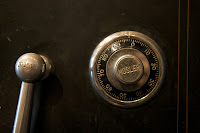 |
| Photo by Marcin Wichary |
What I found interesting in this document called Instructions on Required Proofs that Grandpa received from the Social Security Administration, is that there were two categories under Proof of Age.
Social Security preferred documents from the first category- Documents Usually Recorded in Early Life. Notice the last item - f - U.S. census record for the first or second census after birth. That is what Richard obtained back in 1960 (see Post 2). I was surprised that the first or second census record after someone's birth would fall into this category.
Here was another surprise. In the second section, is a list of documents that could be used if a document recorded early in life was not readily available. Note item s - Delayed birth certificate.
Maybe I am mistaken but it seems like I've read, in several places, that people born before vital records were required to be kept often would obtain a delayed birth certificate in order to collect Social Security benefits. Yet here on this form from 1965 (see the year on the bottom of the form), the Social Security Administration is saying that a census record for the first or second census after birth is preferable to a delayed birth certificate. Very interesting.
Richard did end up sending in his Census Bureau transcript as proof of birth asking that it be returned to him, which it was (see Exhibit 5 below).
Summary
Sometimes in our research we need to accept that not finding something is still a good thing. I am thinking there is no reason to continue looking for a birth certificate for Grandpa, or a delayed birth certificate. He used a 1900 Census Bureau transcript as proof of his birth with the Social Security Administration probably because a birth certificate doesn't exist.
Going back to the original hypothesis in Part 1: Richard Roos was born 7 August 1895 in Los Angeles, California. It looks like I may have to be satisfied with the other sources I already have that prove this. That's OK as I have plenty of convincing evidence that my hypothesis is true (not to mention the fact that I used to send Granpa a birthday card every August!). If I could just get the Archdiocese of Los Angeles to cough up the baptismal record...
I hope you enjoyed this series and that it helps you with solving a genealogical problem of your own.
Exhibit 5 - Letter from Richard Roos to Social Security, dated 4 November 1965,submitting proof of birth
© 2011, copyright Michelle Goodrum



Enjoyed this series Michelle! Well done! It sounds like you have at least some other things that can keep you satisfied with the birth. Very interesting, thank you for posting!Oh and good luck with the baptism record!
ReplyDeleteJust a wild guess from an old lady, but it seems likely that a 1st or 2nd census would be a better and more TRUTHFUL proof than something that could be "manufactured" as an adult.
ReplyDeleteAs a dependent child, your parents would be attesting to your age, your very existence. What would be the incentive to falsify a record back then? There was no ADC, no freebies.. nothing to gain.
Once you were old enough to "speak" for yourself and had your own household, you could 'possibly' fudge a little on your DOB, maybe the spelling of your name..etc Something to hide might be a motivation. My grandmother's brother killed a man in a bar fight, escaped from jail.. went to IL from SC, took his mother's maiden name, married and raised a family... lied on every census.
However, he is listed on a census when he was 9. His 2 daughters are now in their 80's and didn't find out about their dad until they were adults. I would definitely take an early census record as a "good" proof.
Great series! I love the feeling of being "a detective" to solve our genealogy puzzles! Makes me want to get out a magnifying glass and funny hat!
ReplyDelete